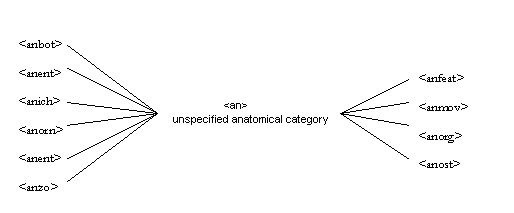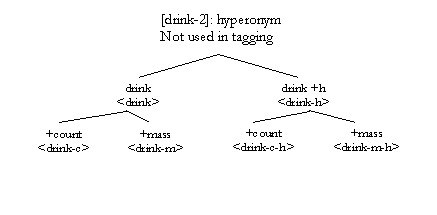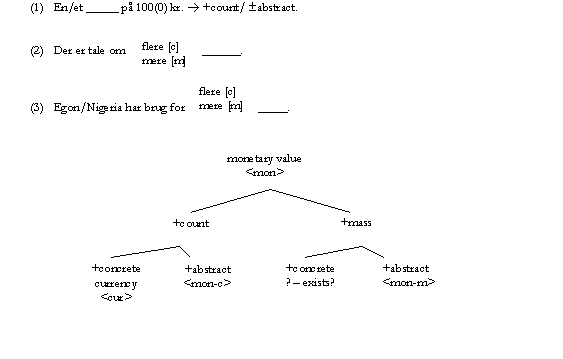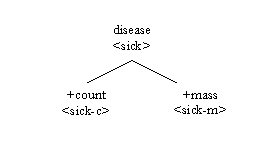| Danish VISLSentence AnalysisEdutainmentCorporaDictionaries |
Semantic
Prototypes: Notes on Definition and Explanations (work in
progress)
General Principles
Tagging is based on the notion of prototype, an (idealized) best instance of
a given category.
Discrete Tagging
The individual tags are independent tags, i.e. they are not used in a sense
where <tag1> is further specified by <tag2>. In a few instances,
however, this principle of discrete tagging has been violated, but at present
these instances have been left in the corpus.
Underspecification
Tags which underspecify a given noun have been applied in the following
cases: 1) Missing knowledge. A more specific tag has not been applied as the
specific nature/meaning is not known.
(2) The noun has several meanings/uses, e.g. "brød" (bread) which has
both a count and a mass meaning: Hun købte 3 brød., Vil du have mere brød?.
Hyperonyms and Hyponyms
Where
hyperonyms
have been defined, the relevant hyponyms can be moved to this group by way of
implication. Apparent doubletagging appears where necessary due to several,
discrete meanings, e.g. thorax_N
<an><anent>.
Polysemy
At this stage, polysemy - a noun with several different, discrete meanings - has only been partially
marked in the corpus.
Polysemy can be marked on the individual word through the use of several tag
categories. Most polysemy relations are, however, marked at
(sets of) tag category level. Well established sets of polysemy relations are
e.g. (1) animal - food, (2) geographical location - human group, (3) fruit -
plant, (4) human group - institution - building, (5) semiotic artifact -
information.
Reading the Table
The table is divided into three columns:
Column 1: Tag category.
Column 2: Definition, (possible) explanation(s) and comment(s) on the tag
category.
Column 3: Examples of the tag category.
In some instances a set of related tag categories is followed by graphics and
additional comments and explanations, e.g. the set of <an> related
categories (see here). The graphics
in general provide a simple illustration of the tag set taxonomy along with
decision procedure comments and the like. The graphics currently available are
not fully developed, nor are graphics available for every tag set.
Animate human, cf. also <inst>
|
Human
being |
|
|
|
Relative,
family member |
afkom,
fyrstedatter, forsørger, fætter, grandkusine, mor, plejeforælder, slægt,
ægtefælle, ætling |
|
|
Follower/supporter
of religion, politics, art etc. |
altruist,
ayatollah, egoist, evolutionist, kommunist, kubist, moralist, muslim,
mystiker, purist, revanchist, skriftefader, Venstrekvinde |
|
|
Mythical
or fictional figure |
antikrist,
drillenisse, engleskare, haltefanden, julemand, krigsgud, mosekone, spøgelse,
supermand, troldkone,
tordengud, varulv, åndevæsen |
|
|
National,
ethnic or geographically/based identity |
alsing,
brønderslevbo, buskmand, chicano, EF-borger, fynbo, halvjøde, indlænding,
hjemmetysker, jydetamp, landsmand,
litauer, squaw, tallerkenneger |
|
|
Profession |
arkitekt |
|
|
Group of
human beings |
a-landshold,
amatørkor, arbejderklasse, bestyrelse, delstatsregering, eksekutivkomite,
fløjparti, fredskorps, hjælpetjeneste, idrætsklub, kokainmafia, kærestepar,
køkkenpersonale, læserpublikum, marchorkester, musikforening, partyband,
småborgerskab, talsmænd, trafikudvalg, tyende, tyvepak, åndsaristokratiet |
Animate
non-human, moving
|
Animal:
hyperonym: underspecified category |
avlsdyr,
dyr, handyr, jagtbytte, padde, lykkedyr, omstrejfer, udyr, ådselæder |
|
|
Bacterium,
microorganism |
|
|
|
Domesticated
animal, pet |
angoraged,
avlshoppe, droschehest, førerhund, kamel, køter, lam, marsvin, malkeko,
samojede, svinehold, øfgris |
|
|
Insect |
borebille,
humlebi, målerlarve |
|
|
Fish,
animals primarily living in water |
brændegople,
musling, sæl, torsk |
|
|
Mythical
animal |
drage,
fantasidyr, midgårdsorm |
|
|
Bird |
brevdue,
duefalk, fjerkræ, grønspætte, gøgeunge, julegås, kylling, solsort |
|
|
Animal
which lives on the ground |
beagle,
brontosaurus, egern, gnaver, husmus, jerseykvæg, kronvildt, malkeko,
primat, vaps, vildt |
|
|
Group of
animals |
bisværm,
forspand, fuglevildt, hjord, hundekobbel, kobbel, sildestime,
torskefangst, ynglebestand |
Animate
non-human; non-moving
|
Plant:
hyperonym |
agave,
begroning, bladplante, dyndurt, engelskgræs, foderplante, giftplante, græs,
havplante, humle, novemberkaktus, siv, sukkulent, åkande |
|
|
Bush |
egekrat,
gyvel, merian, slåenbush |
|
|
Flower |
amaryllis,
gøgelijle, julerose, lotus, okseøje, orkideplante, solsikke |
|
|
Tree |
balsatræ,
bjergfyr, palme |
|
|
Group of
plants |
bed,
bevoksning, blomsterpark, fyrreskov, jordbærbed, jungle, mangrove, rækkehushave,
spinatbed, tajga, troldeskov |
|
|
|
|
|
|
Fruit,
vegetable, nut, etc. |
blomkål,
hvidløg, majs, okra, selleri |
|
|
Fruit,
vegetable, nut, etc. |
abrikos,
bittermandel, kartoffel, grøntsag, ribs, foderroe |
|
|
Fruit,
vegetable, nut, etc. |
*citrus,
*persille, *spinat, *yams, citrongræs, dild, kinaløg, pibeløg, purløg |
Ad
<fruit>
This category includes atypical <fruit>, e.g. dild, svampe,
kartofler, nødder, foderroe.
No distinction is made between human or animal food.
This category does not include pieces of fruit as these do not grow anywhere,
e.g. appelsinbåd. Such nouns are categorized as <food-c>.
It still has not been decided whether hvede, rug, hørfro etc.
ought to be categorized as <fruit>: Der gror hvede på marken.
Polysemy relationship: <fruit> ↔ <B>
Hyperonyms: <B>, <food>
The -c and m tagging is based on the following prototypical usage:
![]() (1)
_____
står flot i år.
(1)
_____
står flot i år.
(2) Vil du have
_ ____ med hjem?
If both taggings are possible or the matter has been left undecided à
<fruit>
If a word as has been tagged as either c or m, this tagging does not
exclude another usage than the one designated. If one moves up the simple
<fruit> hierarchy, both readings (-c and m) are possible.

Topologicals (mostly concrete, non-moving)
|
Anatomy:
not specified |
clitoris,
haleparti, hjerteregion, håndled, kønsåbning, mellemfod, mundhule,
saltkar, tandkødsrand, åndehul |
|
|
Anatomical
feature |
amorbue,
ansigt, braknæse, dievorte, fingeraftryk, filipens, gedeskæg, hudlap,
hestehale, kirsebærmund, næserod, rokketand, talgknop, tommerfingernegl,
ørenhår |
|
|
Movable
anatomical parts |
ankel,
arm, drengekrop, dyrekrop, hjulben, numse, rumpet, tentakel, tommelfinger,
vrist |
|
|
Organ |
balanceorgan,
biceps, bitestikel, blindtarm, bruskvæv, bugspytkirtel, lillehjerne,
lymfekar |
|
|
Bone |
falanks,
fodrodsben, hofteled, kranievæg, kæbeben, menneskeknogle, rygsøjle, rørknogle,
taphvirvel, underekstremitet |
|
|
|
|
|
|
Plant
anatomy. |
bananblad,
bladribbe, bægerblad, frøkappe, grankogle, limeskal, mynteblad,
selleritop, tobaksblad |
|
|
Insect
anatomy |
brod,
dækvinge, flueben, thorax, vinge |
|
|
Fish
anatomy. |
blækspurttearm,
gatfinne, gælle, hvaltand, skæl, stenbiderrogn |
|
|
Bird
anatomy. |
andedun,
fjerdragt, hønsetarm, kråse, ravnenæb, ørneklo |
|
|
Animal
anatomy |
abehånd,
dyrehår, dækhår, hestehale, kode, mellemmave, slangehoved, snabel,
sneglehus, æselryg |
<an> and subcategories
<an> can be divided into two kinds of anatomical features: (1) anatomical
features based on types
(human/animate and plant) and (2) anatomical features based on anatomical
function.
The two kinds of anatomical features (tags) are not equivalent, as the
anatomical features based on types have matching generic tags (<Azo>,
<Aorn> etc.), whereas such matching tags do not exist for the anatomical
tags based on function, as these are independent of type in this connection. A
system with more specific anatomical tags such as e.g. <anent-mov>,
<anent-org> etc. has been ignored here due to ease of processing and
desired level
of distinction.
The anatomical functions are primarily +human in this corpus. An <anmov>
tag is thus underspecified to a certain degree, as its most important trait is
+anatomical movable and not type. <anmov> can thus be applied to a word
which is +anatomical movable for several t ypes.
The different anatomical tags can be summarized like this:

<an> is thus ahyperonym for the types as well as the functions.
Topologicals (mostly concrete, non-moving)
|
Building,
structure. |
adelsgods,
blokbebyggelse, farm, fjeldhytte, fyrtårn, hacienda, iglo, laptelt,
lavbro, længe, shelterdæk, triumfbue, viadukt, wigwam |
|
|
Container |
aljebeholder,
benzindunk, blækhus, cognacglas, flaske, flyttekasse, grøntsagsskuffe,
indkøbstaske, junge, kagetallerken, kop, lammelærke, penalhus,
pilekogger, postsæk, potte, ransel, rygsæk, skraldespand, stenkar, trækasse,
øsekar |
|
|
Direction |
|
|
|
Institution |
|
|
|
Location/topological
place |
|
|
|
Cover
location |
|
|
|
Humanmade
location. |
|
|
|
Mythical
location |
lykkeland,
parnas, perleport, underverden |
|
|
Path,
road etc. |
|
|
|
Picture
location |
|
|
|
Star,
asteroid, planet |
|
|
|
Surface
location |
|
|
|
Tip
location |
|
|
|
Natural
location |
|
|
|
Trap
location |
|
|
|
Water
location. |
badested,
fjord, geyser, indsø, mergelgrav, reservoir, stræde, svømmebad,
vandpyt, yngledam, å |
|
|
Opening/object
with opening |
|
|
|
Situation |
|
|
|
Weather |
|
|
|
Weather |
|
|
|
Weather |
|
|
|
Weather:
precipitation |
|
|
|
Weather:
wind |
|
Concrete, moving
|
Vehicle:
unspecified hyperonym |
befordringsmiddel,
benzinsluger, ekspres |
|
|
Airborne
vehicle |
fragtfly,
raket, ufo |
|
|
Ground
vehicle |
cykel,
dollargrin, fodervogn, hyrevogn, løbehjul, plæneklipper |
|
|
Water
vehicle |
bilfærge,
enerkajak, ubåd
|
|
|
Group of
vehicles |
flotille,
flåde, armada |
Concrete, non-moving (+movable)
|
Concrete
object |
|
|
|
Concrete
object: humanmade |
|
|
|
Fire
object |
|
|
|
Organic
object |
|
|
|
Stick
object |
|
|
|
Round
object |
|
|
|
Mass |
|
|
|
Mass:
humanmade |
|
|
|
Liquid |
|
|
|
Liquid:
humanmade |
|
|
|
Gas |
|
|
|
Gas: humanmade |
|
|
|
Accessories |
amulet,
briller, hattenål, korkbælte, manchetknap, sølvsmykke, tandbøjle |
|
|
Animal
clothing |
buggjord,
hestesko, loppehalsbånd, sadel, seletøj, skaberak, valrap |
|
|
Human
clothing |
alpehue,
badekåbe, barfodssandal, dress, flyverhjelm, gasmaske, harnisk,
herrelingeri, jumper, kittel, kvindetøj, lærredsbukser, muffe, pigsko,
sarong, waders |
|
|
Drink |
drikkevand,
gedemælk, gudedrik, kildevand, mælk, næringsvæske, opkvikker, tevand,
tæring, væske, tørstslukker |
|
|
Drink:
humanmade |
akvavit,
brombærsaft, coca-cola, elskovsdrik, espresso, heksebryg, kaffefløde,
maltøl, moselvin, pastis, slotsaftapning, æggesnaps |
|
|
Drink |
drik,
forfriskelse, forfriskning |
|
|
Drink:
humanmade |
bajer,
hivert, hjertestyrkning, hybenkradser, kaffetår, opstrammer, mælkeprodukt,
sjus, spids, tevandsknægt, æselspark |
|
|
Drink |
drikkelse,
drikke, komælk, modermælk, råmælk |
|
|
Drink |
aftenkaffe,
alkohol, honningmælk, mjød, rævepis, sake, spiritus, sprit, sprut, æggemælk |
<drink>
Many words with the tag <drink> or <drink-h> also have a <cm-liq-
tag, e.g. ananasjuice, æblejuice and other juices.
Many <drink> can be used both in a c and a m context. When used in a
c context there is not necessarily any number congruence between numeral and
noun: Han købte 2 juice-Ø.

Concrete,
non-moving (+movable)
|
Food |
andelår,
frikadelle, kalkun, lam, rosmarin, t-bone-steak, vildt |
|
|
Food:
humanmade |
astakage,
borgmesterstang, dyreragout, gedeost, hyggemiddag, kefir, sagovælling,
vaniljeis |
|
|
Food |
ananasring,
flodkrebs, hasselnøddekerne, hvidløgsfed, oksebøf, råvare |
|
|
Food:
humanmade |
bolle,
chokoladekanin, frankfurter, isterning, kåldolmer, mariekiks, spise, æggemad |
|
|
Food |
bacon,
føde, hestekød, kogeflæsk, restemad |
|
|
Food:
humanmade |
atamon,
grovmel, fars, havregrød, lørdagsslik, rysteribs, tarteletfyld |
<food> and subcategories
The m tagging includes (1) morphological mass nouns, e.g. grød,
mad, [various spices], bacon, mel, hachis, foder
and (2) nouns prototypically mass in usage, e.g. andefedt,
atamonpulver, bihonning, fars, mysli, salt,
marcipanmasse.
Many spices are both c and m, e.g. basilikum: the plant[c], the
spice[m].
The tagging is based on the following c (flere)/-m (mere) distinction:

Concrete,
non-moving (+movable)
|
Furniture |
almuemøbel,
bardisk, briks, drømmeseng, foldevæg, hundekurv, linnedskab,
marokkopude, reol, solarium |
|
|
Material |
andedun,
bast, bjørneskind, fåreuld, hamp, hvaltand, kapok, korkeg, kvartsit,
lambswool, læder, mahogni, naturmateriale, rav, rågummi, teak |
|
|
Material:
humanmade |
acetatsilke, avispapir, celluloid, cement, drivtømmer, fleece,
glasfiber, guldlame, karduspapir, krystalglas, limtræ, linned, møbelstof,
pvc, stoppegarn, stål, tyl |
|
|
Monetary
value |
|
|
|
Currency |
belgierfranc, dollar, finmark, pundseddel, rand, real, rupee, unse,
yen, zloty, øre |
|
|
Monetary
value |
acontobeløb,
affaldsafgift, billetpris, boligunderskud, entreindtægt, fedterøvstillæg,
erstatningssum, fragtrate, giroindbetaling, lærerlønning, luftpostfrimærke,
parkeringsbøde, refundering, skattelettelse, stjernegage, sølvbarre,
tusse, valutabeholdning, vekselkurs |
|
|
Monetary
value |
arbejdsløn,
bibliotekspenge, fædrenearv, kontanthjælp, læsegæld, porto,
rentearbitrage, transittold, udviklingsbistand |
<mon>
The taxonomy is not complete, nor can it satisfactorily deal with currency terms
which are concrete, but not typical, e.g. blankocheck,
femhundredekroneseddel.

Concrete,
non-moving (+movable)
|
Part (of whole) |
|
|
|
Semiotic |
|
|
|
Semiotic: can be heard (listened to) |
|
|
|
Semiotic:
can be read |
|
|
|
Semiotic:
can be seen (watched) |
|
|
|
Tool |
|
|
|
Tool for
cutting, chopping |
afretterhøvl,
barberkniv, bøddeløkse, havesaks, hugvåben, kokkekniv, krumsabel,
savklinge, skæreblad, spid, springkniv, tomahawk |
|
|
Tool for
music/musical instrument |
alpehorn,
basun, cello, elbas, flygel, kastagnet, klokkespil, lirekasse, luftgitar,
stradivarius, trillefløjte, træblæseinstrument, xylofon |
|
|
Tool for
sailing |
|
|
|
Tool for
shooting |
armbrøst,
automatvåben, jagtgevær, karabin, langbue, luftværnskanon,
maskinpistol, skræmmevåben, slynge, snaphane, vandpistol |
|
|
Tool for
binding/tying |
ankertov,
gavebånd, hampreb, hundesnor, høstbindingsgarn, hårbånd, lænke, reb,
snørebånd, sytråd, tøjr, wire |
Abstract
|
Abstract |
|
|
|
Abstract
category |
|
|
|
Abstract
sign |
|
|
|
Abstract |
|
|
|
Colour |
|
|
|
Convention |
|
|
|
Feature |
|
|
|
Psychological/mental
feature |
affektion,
afsavn, fortællekunst, nærtagenhed, frisind, fromhed,
grundvandsinteresse, handlekraft, hjemlængsel, intuition, jeg-følelse, kækhed,
martyrmine, melankolskhed, målbevidsthed, panik, realitetssans, sindelag,
skriftkloghed, snakkelyst, uforståenhed, ædelmod |
|
|
Physical
feature |
antændelsestemperatur,
arrethed, asfaltboble, behårethed, boligstand, flydeevne, goldhed,
isagtighed, isolationsevne, jakkelomme, kjolesøm, kontursting, kønhed,
mugplet, pukkelryggethed, puld, skaktern, skorpe, slidstyrke, solmodenhed,
vanskabthed, varmeledningsevne, vaskbarhed |
|
|
Physical
human feature |
altstemme,
blegnæbbethed, ernæringstilstand, fordrukkenhed, følelsesløshed,
hjulbenethed, høreevne, hårdtsårethed, kendermine, kondition,
kropsvarme, kæmpeskikkelse, røntgenblik, skæggethed, smidighed,
stamina, sult, trællemærke, øjenskygge |
<f>
Note. <f> is unpecified as to whether the feature in question is
psychological or physical. <f> is also unspecified as to whether the
feature is ±human.

Abstract (cont.)
|
Cognitive
domain |
aerodynamik,
botanik, børnepsykiatri, drømmeforskning, edb-teknik, ejderpolitik,
eskimologi, fagvidenskab, folkemedicin, fredsforskning, gruppeterapi,
journalisme, medieformidling, motivationspsykologi, |
|
|
Right,
social property |
|
|
|
Geometrical
form |
|
|
|
Theory,
style of art, religion etc.. |
anarkisme,
apartheid, biedermeier, humanisme, jesuitisme, kabbala, naturreligion,
nazisme, rundbuestil, senmodernisme, shiisme, trosretning, voodoo, zen, økologi |
|
|
Language |
bantu,
barnesprog, cockney, dialekt, farsi,
fingersprog, fremmedsprog, |
<domain>, <ism> and
<ling>
domain-2
The hyperonym <domain-2> - which has not been applied in tagging is
based on the following prototypical contexts:

Abstract (cont.)
|
Transparent
metakategori. |
afart,
andenudgave, flig, fragment, pukkel, sammenrend, strejf, særversion,
type, udpluk, undergruppe, væld |
|
|
A
cognitive act. |
anelse,
association, associering, erindringsglimt, fornemmelse, forudanelse,
indskydelse, skrupel, uråd |
|
|
The
result of a cognitive act. |
allroundviden,
anfægtelse, atomstrategi, beslutning, barnedrøm, dagsordensforslag,
EF-plan, erindring, fantasirejse, fejlfortolkning, forståelse,
grundtanke, gætværk, historieteori, indbildning, jordspekulation,
livsanskuelse, livsløgn, mødeplan, revurdering, påfund,
samfundsopfattelse, standsfordom, virkelighedsflugt |
|
|
Perception |
|
|
|
Perception:
can be heard (listened to) |
|
|
|
Perception:
can be smelled (olfactory sense) |
aroma,
blomsterduft, fims, fis, gaslugt, moskus, odør, parfume, roll-on,
stinkbombe, velduft |
|
|
Perception:
can be felt (a touch). |
kildren,
krablen, sitren, spjæt, spasme, sting, ve, ømhed |
|
|
Perception:
can be tasted |
beskhed,
eftersmag, frugtsmag, løgsmag, nøddesmag, smagsoplevelse, smagsprøve,
syrlighed, sødmefuldhed, sødme |
|
|
Perception:
can be seen (watched) |
aftendæmring,
efterårsmørke, flammeskær, gadebelysning, glimt, hallunication,
himmellys, katastrofeblink, luftspejling, lys, lyssignal, messingglans, nødblus,
synsbedrag, udsigt, vue |
<percep> and subcategories

Abstract (cont.)
|
Representation |
|
|
|
Disease |
|
|
|
Disease |
alkoholsygdom,
blist, brandbyld, fobi, HIV-infektion, hjernetumor, hvepsestik, krampetrækning,
kvægsygdom, lårbensbrud, slangebid, tennisalbue, åreknude |
|
|
Disease |
aids,
bronkitis, hjertebanken, kræft, migræne, psoriasis, spat, tuberkulose,
tyfus |
<sick>

Abstract: terms of measurement and amounts;cf. also <cur>, <container>,
<meta>
|
Amount Members
of this category can appear in the following context: |
blok,
bundt, dråbe, favnfuld, hoben, humpel, håndfuld, klat, kopfuld,
maskinfuld, nip, portion, ration, sending, skvis, smule, tylvt, visk |
|
|
Group
(of
) |
anekdotesamling,
fonotek, håndbibliotek, kaffestel, maskinpark, nøglebundt, perlerække,
produktgruppe, regelsæt, skudsalve, stjernehob, tandempar, tyvestykspakke |
|
|
Unit
of measurement. |
|
Acts and events (+V[erbality] feature)
|
Act. |
|
|
|
Act |
|
|
|
Act |
|
|
|
Event |
|
|
|
Event |
|
|
|
Event |
|
<act> and <event>
Tagging of <act> and <event> is based on prototypical usage: -c or
m. When undecided or both taggings possible, a tagging as ither <act>
or <event> has been applied.

Acts and events (+V[erbality] feature)
|
Speech,
talk |
debat,
diskussion, drøftelse, elevsamtale, interview, småskænderi,
topartsforhandling |
|
|
Dance |
borddans,
charleston, gigue, gogo, nøgendans, polka, polonæse, sjæler, æggedans |
|
|
Game,
play |
andespil,
bingo, fangeleg, gnav, halvtolv, kortspil, mausel, mikado, stangtennis,
strippoker, yatzy |
|
|
Sport |
akrobatik,
amatørboksning, børneidræt, crawl, dressurridning, fægtning, højdespring,
military, spring, squash |
|
|
Speech
act |
|
|
|
Speech
product |
|
Time
|
Duration
of time |
|
|
|
Period
of/in time |
|
|
|
Temporal |
|
|
|
Occasion |
|
[1]
<act-play> +mass pr. 2610 (tvivlsomme i
parentes): banko, baseball, bezique, bingo, blindebuk, bob, boccia, boule,
bowling, [
]bridge, canasta, cricket, dart, domino, (dødbold),
[
]fodbold, gnav, go, golf, halvtolv, hasard, hjerterfri, hockey,
karambole, kluddermor, kricket, kroket, langbold, lhombre, lhombre, ludo,
(lykkehjul), (matador), mausel, (mølle), petanque, (pind), (pingpong),
[
]poker, (rommy), rundbold, seksogtres, sjavs, [
]skak, slyngbold,
snooker, solitaire, sorteper, stanto, stikbold, stopbold, (styrvolt), ståtrold,
[
]tagfat, [
]tennis, terre, tipning, [
]tips, [
]whist, yatzy.